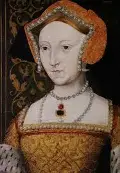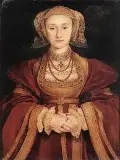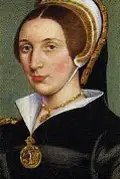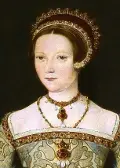King Henry VIII of England
Part 3: Breaks and Heartbreaks
In 1534, Parliament, through the Act of Supremacy, recognized Henry VIII as the head of the church in England. Pope Clement VII excommunicated Henry and Archbishop Cranmer. The Pope's decisions made little difference to Henry and the new Church of England. As he had with his father's unpopular ministers in the early days of his reign, Henry acted decisively in stamping out opposition to his new religion. Those who refused to pledge an oath to the king were punished, sometimes severely. The leaders of the Pilgrimage of Grace, a large-scale rebellion in northern England, were rounded up and, after being promised clemency, executed. Two high-profile men who refused were John Fisher, Bishop of Rochester, and Henry's own chief minister, Sir Thomas More. Both were convicted of high treason and killed. 
In a very severe act of reprisal against the Catholic Church in England, Henry convinced Parliament to pass the Dissolution of the Lesser Monasteries Act in 1536. Essentially, Henry and the Government declared themselves free to have monasteries torn down and their treasuries seized. Twin Suppression Acts that followed reinforced this position. This resulted in a large amount of income for the royal treasury. It also resulted in the devastation of buildings, some of extremely ornate architecture, that had stood for centuries. Henry was still very much in want of a son, and so he began to distrust Anne as he had Catherine. On Jan. 8, 1536, Catherine, long in seclusion, died. Anne was pregnant at the time (with a son) but lost the child through a miscarriage brought on by shock at Henry's life-threatening injuries suffered in a jousting tournament. The king and queen had grown apart, and Anne was rumored to be romantically involved with other men. The fact that the king was rumored, if not known, to be romantically involved with other women was not considered of equal consideration at this time. Anne, along with several men who were charged with being her paramours, was executed for treason on May 17, 1536.
The very next day, Henry was again engaged to be married, again to a queen's lady-in-waiting, this time to Jane Seymour. They were married on May 28, 1536. In October of that year, Henry and Jane succeeded where Henry and both Catherine and Anne had failed, when Jane gave birth to Edward, a healthy baby boy. Henry finally had his son and (preferred) heir. Joy quickly turned to sorrow because the royal wife (who had never been crowned queen) had fallen ill as a result of complications stemming from the difficult birth. She died on October 24. Parliament, through the Second Succession Act, declared Edward the legitimate heir to the throne and made both Mary and Elizabeth illegitimate. In the meantime, Henry set about finding yet another queen. At the suggestion of Thomas Cromwell, now his chief advisor, he agreed to marry a German woman named Anne, the daughter of the Duke of Cleves. The two were married in early 1540. The pair turned out to be not much to each other's liking, and Henry had the marriage annulled the same year it began. On July 28, 1540, he married for a fifth time, to Catherine Howard, who was then 17 and had been a lady-in-waiting of Anne Boleyn. As much as Henry was enamored of his new wife and queen, Catherine Howard was enamored of someone else–two men, in fact. Henry had both men killed and Catherine herself executed, in 1542. The following year, he married for the sixth and final time, to Catherine Parr. She outlived him. It was this Catherine who convinced Henry to declare his daughters legitimate heirs to the throne. A 1543 Act of Parliament confirmed this. Also in 1543, Henry pursued a political alliance via marriage between his son and the infant Scottish queen, Mary. The two countries initially agreed, but a series of political events convinced Scotland to reject the treaty that had sealed the deal and Henry sent troops north to teach Scotland a lesson. This struggle continued for several years. Henry and Catherine were married for four years. Henry died at age 55 in 1547, the victim of obesity brought on by overeating and by chronic illness stemming from the jousting injury that he had suffered more than a decade before. He was so overweight that his court advisors had to invent contraptions to carry him around. (This was in stark contrast to the virile, mobile young king who had enjoyed hawking, hunting, jousting, and other outdoor activities and, when indoors, dancing and carousing.) On the day of his death, Jan. 28, 1547, his son, Edward, succeeded him on the throne. At age 9, he became King Edward VI. First page > King of England > Page 1, 2, 3 |
|
Social Studies for Kids
copyright 2002–2024
David White



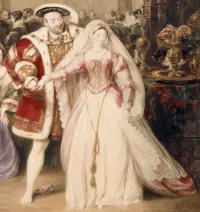 Henry and Anne were secretly married in late 1532. They were publicly married in 1533. The Archbishop of Canterbury, Thomas Cranmer, declared Henry's marriage to Catherine null and void, paving the way for the official acceptance of Henry's marriage to Anne. As well, the king's own daughter, Mary, was declared not a legitimate child of the monarch. Anne gave birth to a girl in September 1533; this girl she named
Henry and Anne were secretly married in late 1532. They were publicly married in 1533. The Archbishop of Canterbury, Thomas Cranmer, declared Henry's marriage to Catherine null and void, paving the way for the official acceptance of Henry's marriage to Anne. As well, the king's own daughter, Mary, was declared not a legitimate child of the monarch. Anne gave birth to a girl in September 1533; this girl she named 